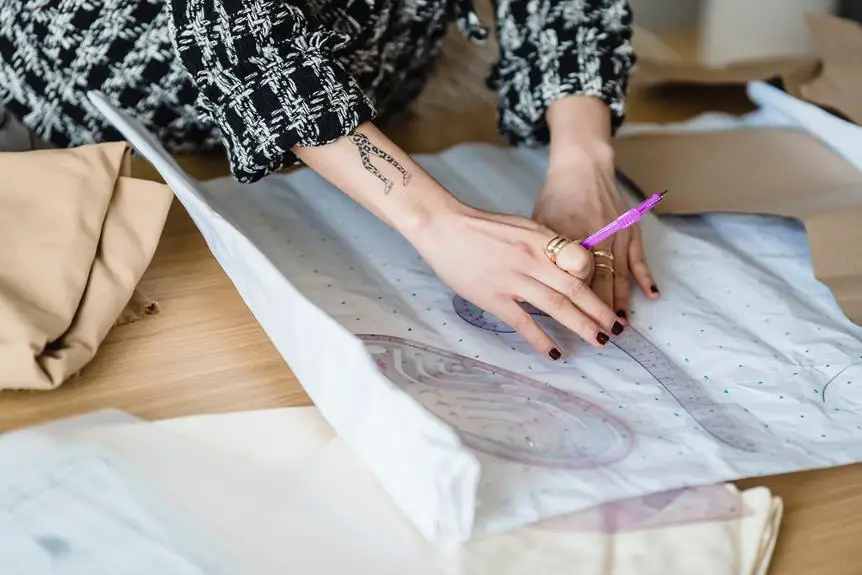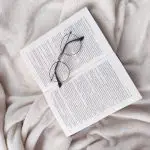When it comes to sewing, the fabric you choose can make all the difference. You want to master the art of selecting the right fabric for each project, and that's where these 9 essential fabrics come in.
From the timeless versatility of cotton to the luxurious elegance of silk, each fabric has its own unique characteristics that can elevate your sewing creations. Whether you're sewing a cozy fleece blanket or a sophisticated satin dress, having a solid understanding of these essential fabrics will give you the mastery you desire in your sewing projects.
So, let's dive into the world of fabrics and take your sewing skills to the next level!
Key Takeaways
- Natural fabrics like cotton, linen, wool, and denim are versatile and durable options suitable for a wide range of sewing projects.
- Luxurious fabrics such as silk, velvet, and satin add elegance and beauty to garments and home decor.
- Rugged fabrics like denim and fleece offer comfort, warmth, and durability for various sewing projects, including DIY projects.
- Specialized fabrics like lace and quilted wool add femininity, texture, and warmth, making them suitable for creating accessories and outerwear pieces.
Cotton
When you're planning your sewing projects, it's important to consider using cotton, as it's a versatile and durable fabric that's suitable for a wide range of garments and crafts.
Cotton is a favorite among seasoned sewers for many reasons. Its breathability and moisture-wicking properties make it ideal for creating comfortable clothing, while its strength and durability ensure that your creations will stand the test of time.
When working with cotton, it's essential to master a few key sewing techniques to make the most of this fabric. Due to its tendency to shrink, prewashing and drying your cotton fabric is crucial before you start cutting and sewing. Additionally, using the appropriate needle and stitch length can make a significant difference in the outcome of your project.
When it comes to fabric care, cotton is relatively low-maintenance. Most cotton items can be machine washed and dried, but it's essential to follow the care instructions to prevent any unwanted shrinkage or damage.
Silk
To achieve a luxurious drape and a lustrous finish in your sewing projects, consider incorporating silk into your fabric collection. Silk is renowned for its luxurious sheen, delicate, and smooth texture, making it a top choice for elegant and high-quality garments. This exquisite fabric drapes beautifully, adding an element of sophistication to any design. Whether you're creating a stunning evening gown, a delicate blouse, or luxurious linings for jackets, silk elevates the overall look and feel of your creations.
When working with silk, it's important to handle it with care due to its delicate nature. Use fine, sharp needles and opt for quality silk thread to ensure seamless stitching. Pre-washing silk fabric is advisable to prevent any potential shrinkage or color bleeding after the garment is made.
Silk comes in various types such as charmeuse, chiffon, and crepe de chine, each offering unique qualities for different sewing projects. From its luxurious sheen to its ability to effortlessly flow, silk is a versatile fabric that adds an element of elegance and refinement to any garment.
Embrace the beauty and sophistication of silk as you enhance your sewing repertoire.
Denim
Consider incorporating denim into your fabric collection for durable and versatile sewing projects. Denim is a timeless fabric that adds a touch of rugged elegance to any garment. Whether you're a beginner or an experienced seamstress, denim offers endless possibilities for creativity and style.
Here are some essential tips and ideas to make the most out of your denim fabric:
- Denim care: Properly washing and caring for denim is crucial to maintain its color and texture. Learn the best practices to keep your denim creations looking fresh and vibrant.
- Denim styling: Experiment with different washes and weights to achieve the perfect look for your project. From classic indigo to trendy acid wash, denim offers a wide range of styling options.
- Denim DIY: Explore fun and practical DIY projects using denim, such as creating stylish tote bags, aprons, or even reworking old denim garments into new fashion pieces.
- Denim trends: Stay updated on the latest denim trends and incorporate them into your sewing projects. Whether it's distressed denim or patchwork designs, keeping an eye on trends can inspire your creativity.
Incorporating denim into your sewing endeavors opens up a world of possibilities, from classic jean jackets to trendy denim dresses. Embrace the durability and versatility of denim to elevate your sewing projects.
Wool
When it comes to sewing, wool is a fabric you don't want to overlook. Its natural warmth and insulating properties make it a must-have for chilly weather.
Plus, its versatility and durability make it an ideal choice for creating stylish outerwear that will last.
Warm and Insulating
For sewing projects requiring warmth and insulation, you'll find that wool is an essential fabric to consider. Wool's natural insulating properties make it a versatile choice for various cold-weather sewing projects.
When working with wool for warm and insulating projects, consider the following:
- Thermal Fabrics: Look for wool blends or double-faced wool for maximum warmth.
- Layering Techniques: Experiment with layering wool fabrics to create garments that provide exceptional insulation.
- Quilted Materials: Utilize quilted wool fabrics for added warmth and texture in your winter sewing projects.
- Cozy Accessories: Use wool to make cozy accessories such as scarves, hats, and mittens to keep you warm during cold weather.
- Classic Outerwear: Create timeless outerwear pieces like coats and jackets using wool to ensure both style and warmth.
Wool's natural insulating properties make it a versatile choice for various cold-weather sewing projects.
Versatile and Durable
As you explore options for your sewing projects, wool stands out as a versatile and durable fabric that offers a wide range of creative possibilities. When it comes to fabric selection, wool is a top choice due to its natural resilience and adaptability. Whether you're creating a cozy winter coat or a stylish skirt, wool can elevate your sewing projects with its luxurious texture and exceptional durability. Additionally, wool is incredibly versatile, making it suitable for various sewing techniques such as tailoring, pleating, and embroidery. To highlight the benefits of wool in sewing, take a look at the table below:
| Wool Fabric Benefits |
|---|
| Natural Resilience |
| Luxurious Texture |
| Versatility |
Incorporating wool into your sewing projects will undoubtedly elevate your creations, providing both durability and sophistication.
Ideal for Outerwear
Explore the versatility of wool for your outerwear projects, ensuring durability and style with this exceptional fabric.
Wool is a timeless choice for outerwear due to its remarkable properties. It's waterproof and durable, making it ideal for withstanding the elements. Additionally, wool is lightweight and breathable, ensuring comfort without compromising on warmth.
Its natural insulating properties provide excellent protection against the cold, making it perfect for creating cozy and stylish outerwear pieces. When you choose wool for your outerwear projects, you're opting for a fabric that not only offers functionality but also exudes sophistication and elegance.
Elevate your outerwear collection with the unmatched qualities of wool.
Linen
Linen is a breathable and versatile fabric that's perfect for warm weather. Its natural fibers allow for airflow, making it comfortable to wear even on the hottest days.
Whether you're sewing a summer dress or lightweight curtains, linen is an ideal choice for a wide range of projects.
Breathable and Versatile Fabric
Discover how linen fabric can elevate your sewing projects with its breathability and versatility. Linen is a game-changer, offering moisture-wicking performance and all-season comfort.
Here's why linen should be your go-to fabric:
- Breathability: Linen's natural fibers allow air to flow, keeping you cool and comfortable.
- Versatility: It's perfect for a wide range of garments, from summer dresses to lightweight jackets.
- Durability: Linen is strong and long-lasting, ensuring your creations stand the test of time.
- Elegance: Its natural texture and drape add a touch of sophistication to your designs.
- Sustainability: Linen is eco-friendly, requiring less water and pesticides to grow.
Embrace the magic of linen and take your sewing projects to the next level!
Ideal for Warm Weather
For warm weather sewing projects, consider using linen as it offers excellent breathability and comfort.
Linen is a lightweight and breathable fabric, making it one of the best summer-friendly options for your sewing projects. Its natural fibers allow for air circulation, keeping you cool and comfortable even in the hottest weather.
When sewing with linen, you can create stylish and comfortable garments such as flowy dresses, loose tops, and breathable bottoms that are perfect for the summer season. Its versatility allows you to experiment with different styles and designs, providing you with endless possibilities for your warm weather wardrobe.
Whether you're making casual everyday wear or elegant summer outfits, linen is a go-to fabric for achieving both style and comfort in hot temperatures.
Velvet
When sewing, you can't go wrong with the luxurious feel and elegant drape of velvet fabric. Velvet is a timeless and versatile material that adds a touch of sophistication to any sewing project. Here are five reasons why velvet is an essential fabric for every sewing enthusiast:
- Luxurious Texture: Velvet's soft and plush texture adds a touch of luxury to garments, making them feel incredibly elegant and comfortable to wear.
- Rich Color Options: Velvet fabric comes in a wide range of rich, deep colors, allowing you to create stunning, eye-catching pieces for any occasion.
- Elegant Drape: The graceful drape of velvet makes it ideal for creating flowing gowns, elegant curtains, and luxurious home decor items.
- Versatile Applications: From creating stunning evening wear to adding a touch of luxury to upholstery projects, velvet is a versatile fabric that can elevate any sewing endeavor.
- Timeless Appeal: Velvet has been a symbol of luxury and opulence for centuries, making it a timeless choice for sewing projects that exude sophistication and class.
With its luxurious texture and versatile upholstery applications, velvet is a must-have fabric for any sewing project that calls for a touch of elegance and refinement.
Satin
You'll find that satin is a versatile fabric with a smooth and lustrous surface, perfect for adding a touch of elegance to your sewing projects. Satin drapes beautifully, making it an excellent choice for creating luxurious garments, formal wear, lingerie, and elegant home decor items. Its glossy surface reflects light, giving it a luxurious sheen that adds a sophisticated touch to any project.
When working with satin, it's essential to handle it carefully to achieve the best results. To ensure that your satin creation turns out flawlessly, pay attention to the fabric's care instructions. Satin is often delicate and may require special handling, such as gentle hand washing or dry cleaning to maintain its luster and integrity.
Additionally, understanding how satin drapes and flows is crucial for creating stunning, well-fitted garments. Take the time to practice working with satin, experimenting with its drape, and observing how it behaves to master the art of sewing with this elegant fabric.
With the right techniques and attention to detail, you can elevate your sewing projects with the timeless beauty of satin.
Lace
After working with the smooth and lustrous satin, it's time to explore the delicate beauty of lace, which adds a touch of intricate elegance to sewing projects. Lace is a fabric with a rich history, known for its feminine and elegant appeal. Here are five reasons why lace should be a staple in your sewing projects:
- Timeless Femininity: Lace exudes a timeless, feminine charm that can elevate any garment or accessory, adding a touch of romance and grace.
- Intricate Designs: The delicate and intricate patterns of lace can bring a sense of sophistication and luxury to your creations, making them truly stand out.
- Versatile Elegance: Whether you're creating a bridal gown, a delicate blouse, or an elegant table runner, lace lends an air of elegance and refinement to any project.
- Textural Depth: The unique texture of lace adds dimension to your designs, creating visual interest and a tactile allure.
- Classic Appeal: From vintage-inspired looks to modern designs, lace has a classic appeal that transcends trends, making it a versatile choice for various styles and aesthetics.
Integrating lace into your sewing projects allows you to infuse them with a sense of timeless beauty and intricate sophistication.
Fleece
To add warmth and coziness to your sewing projects, consider incorporating fleece as a versatile fabric option. Fleece is a soft, warm, and lightweight material that's perfect for creating comfortable garments and accessories. Its insulating properties make it an excellent choice for sweatshirts, jackets, blankets, and hats, keeping you snug during chilly days.
Fleece is also moisture-wicking, making it ideal for activewear and outdoor gear, as it helps to keep you dry and comfortable during physical activities. When working with fleece, it's important to understand its properties and uses. Fleece comes in different weights, from lightweight to heavy, allowing you to choose the most suitable option for your project. This fabric is easy to sew and doesn't fray, making it perfect for beginners and advanced sewists alike.
Additionally, fleece is machine washable and dries quickly, making it low-maintenance for everyday use. For proper fleece care and maintenance, it's recommended to wash it in warm water and tumble dry on a low setting to maintain its softness and shape. Avoid using fabric softeners as they can reduce the fabric's moisture-wicking properties.
With its versatility and practicality, fleece is a must-have fabric for any sewing enthusiast.
Frequently Asked Questions
Can I Use Denim Fabric for Making a Formal Dress or Office Wear?
You can use denim fabric for making a casual yet stylish dress, but it may not be the best choice for formal wear or office attire. Consider fabrics like satin, silk, or wool for a more professional look.
What Are the Best Types of Silk Fabric for Beginners to Work With?
When working with silk fabric as a beginner in sewing projects, the best types to start with are charmeuse and crepe de chine. These are beginner-friendly and offer a luxurious feel. Remember to handle silk with care for maintenance.
How Can I Prevent Wool Fabric From Shrinking When Washing?
To prevent wool fabric from shrinking when washing, use cold water and a gentle detergent, then lay the fabric flat to dry. Avoid heat and agitation. For denim fabric and formal dresses, follow the care instructions on the label for best results.
Is It Possible to Dye Linen Fabric at Home?
Yes, you can dye linen fabric at home using DIY linen dyeing techniques. Natural dye methods, like using plant-based dyes, can create beautiful, unique colors. Experiment with different natural dye sources for custom linen creations.
What Are the Different Types of Fleece Fabric and How Do They Differ in Terms of Warmth and Softness?
When choosing fleece fabric, consider the type of warmth and softness you desire. Polar fleece offers high warmth and softness, while microfleece provides a lighter, softer feel. Select the right type for your sewing project and care for it accordingly.
- Why Is Red Velvet Not Red? - April 25, 2024
- How Do You Describe Velvet Fabric? - April 25, 2024
- How Strong Is Velvet? - April 25, 2024





